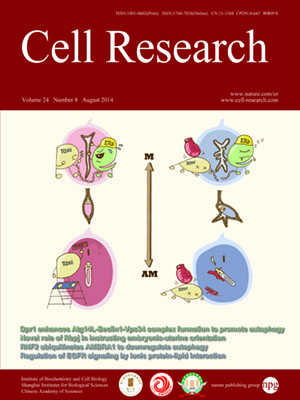
Volume 24, No 8, Aug 2014
ISSN: 1001-0602
EISSN: 1748-7838 2018
impact factor 17.848*
(Clarivate Analytics, 2019)
Volume 24 Issue 8, August 2014: 1013-1016
LETTERS TO THE EDITOR
Lis1 is required for the expansion of hematopoietic stem cells in the fetal liver
Xufeng Chen1,*, Jiali Zhang1,*, Jingyao Zhao1, Haifeng Liu1, Xiang Sun1, Mujun Zhao2 and Xiaolong Liu1
1State Key Laboratory of Cell Biology, Institute of Biochemistry and Cell Biology, Shanghai Institutes for Biological Sciences, Chinese Academy of Sciences, Shanghai 200031, China
2State Key Laboratory of Molecular Biology, Institute of Biochemistry and Cell Biology, Shanghai Institutes for Biological Sciences, Chinese Academy of Sciences, Shanghai 200031, China
Correspondence: Xiaolong Liu,(liux@sibs.ac.cn)
Hematopoietic stem cells (HSCs) are responsible for the lifelong production of all blood cells1. Like many other tissues and organs, the hematopoietic system develops during embryogenesis2. One of the challenges of this developing process is to generate a functional HSC pool, which is a prerequisite for seeding bone marrow and thereafter lifelong hematopoiesis3. HSC expansion is critical for the establishment of such HSC pool2. To accomplish the expansion, the fetal liver HSCs (FL-HSCs) are continuously undergoing symmetric cell division, which requires precise collaboration of multiple cellular processes2, especially those that serve to maintain the genomic stability of the dividing HSCs. Many factors have been shown to be involved in FL-HSC expansion. Growth factors such as insulin-like growth factor 2 (IGF2) and stem cell factor (SCF) stimulate FL-HSC proliferation4,5, and key transcription factors such as Gata2 and PU.1 regulate the proliferation and maintenance of fetal HSCs by regulating multiple downstream target genes6,7. However, the intrinsic factors that directly regulate FL-HSC expansion remain to be investigated.
10.1038/cr.2014.69
FULL TEXT | PDF
Browse 2030


